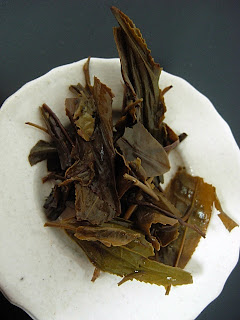
Bet you've never heard of Ddok Cha! Even googling this mysterious tea leads to no relevant results. It seems odd as this tea has such a long history in Korea but is virtually unknown to even the common folk here.
This tea was first used here about 1400 years ago, about the time some people believe tea became popular in Korea. It was particularly fad among monks who frequented the mountains during the Goryeo (918-1392) rule of the peninsula when Buddhism was at its height in Korea. When the Joseon (1392-1897) ousted the Goryeo they began a campaign of repressing everything associated with Buddhism. They ruled by using the principles of Confucianism and claimed that Buddhism was just 'Ooga-Booga'. Because ddok cha was connected to the Buddhist way of life it was ostracized by the ruling class and literi who much preferred the simple green loose leaf variety. If it weren't for the dedicated, zenned-out, tea drinkin' Korean monks we probably would know nothing about this wonderful, nearly forgotten tea.
So, what exactly is Ddok cha already!!! Well 'Ddok' in Korean means pounded congealed rice cake and cha (clearly and most obviously) means tea. This tea isn't made from rice cakes, in fact, it's 100 % pure Camellia sinensis. The word 'Ddok' is used to describe this tea because it has a similar method of production to the famed rice cake. Rice cakes, just like the tea, are produced by placing rice (or tea) on a large stone and beating it repeatedly with a heavy, oversized wooden hammer that, in many ways, reminds me of the kind used to play Wack-A-Mole at the ol' town fair.
The tea leaves used for ddok cha are the small type of Camellia sinensis that are used in the teas of Northern China, Korea and Japan today. These leaves are small and thin and can grow to the full size of 10 cm or less. They are almost exclusively used to make green teas and typically aren't good for oxidizing due to these leaf characteristics. Nevertheless, ddok cha is produced in ways which use and accommodate these specific leaf characteristics to maximize the full-bodied flavour of this tea.
The production process is the exact same as green tea production in Korea and only differs from it in the last few steps of production. Unlike green tea, Ddok cha goes through a process of light oxidization that is initiated when the leaves are given the beats with the giant wood mallet. They are pounded together in a manner that is considerably less dense than the process used to make puerh. In doing so it allows the tea to oxidize in a much different way, where a larger surface area of the oxidizing tea is exposed to air. The tea is left in the shade to oxidize and chill out for only four days or so.
The result is a smaller loosely packed cake that is just a tad oxidized. This tea will give off a liquor that is a bright but hazy yellow colour. It's flavour will continue to mature as the leaves age and will reach full maturity 3 to 5 years after production. Did I mention that it just tastes damn good???









